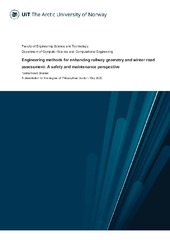| dc.contributor.author | Østvand, Lene | |
| dc.contributor.author | Rypdal, Kristoffer | |
| dc.contributor.author | Rypdal, Martin | |
| dc.date.accessioned | 2014-10-30T08:44:30Z | |
| dc.date.available | 2014-10-30T08:44:30Z | |
| dc.date.issued | 2014-10-30 | |
| dc.description.abstract | Various interpretations of the notion of a trend
in the context of global warming are discussed, contrasting
the difference between viewing a trend as the deterministic
response to an external forcing and viewing it as a slow
variation which can be separated from the background spectral
continuum of long-range persistent climate noise. The
emphasis in this paper is on the latter notion, and a general
scheme is presented for testing a multi-parameter trend
model against a null hypothesis which models the observed
climate record as an autocorrelated noise. The scheme is
employed to the instrumental global sea-surface temperature
record and the global land temperature record. A trend model
comprising both monotonic trend and non-monotonic multidecadal
variability is proposed, represented by a linear plus
an oscillatory trend with period around 70 yr. The statistical
significance of the trends are tested against three different
null models: first-order autoregressive process, fractional
Gaussian noise, and fractional Brownian motion. The parameters
of the null models are estimated from the instrumental
record. The estimated linear trend rejects the null independent
of the strength of the oscillation, but the oscillation amplitude
rejects the null only if the rising trend is taken as significant.
The results suggest that the global land record may be better suited for detection of the global warming signal than the ocean record. | en |
| dc.description | An earlier version of this article is part of Lene Østvand's doctoral thesis which is available in Munin at <a href=http://hdl.handle.net/10037/6391>http://hdl.handle.net/10037/6391</a> | en |
| dc.identifier.doi | 10.5194/esdd-5-327-2014 | |
| dc.identifier.uri | https://hdl.handle.net/10037/6786 | |
| dc.identifier.urn | URN:NBN:no-uit_munin_6391 | |
| dc.language.iso | eng | en |
| dc.rights.accessRights | openAccess | |
| dc.subject | VDP::Mathematics and natural science: 400::Geosciences: 450 | en |
| dc.subject | VDP::Matematikk og Naturvitenskap: 400::Matematikk: 410::Analyse: 411 | no |
| dc.subject | VDP::Mathematics and natural science: 400::Mathematics: 410::Analysis: 411 | en |
| dc.subject | VDP::Matematikk og Naturvitenskap: 400::Matematikk: 410::Statistikk: 412 | no |
| dc.subject | VDP::Mathematics and natural science: 400::Mathematics: 410::Statistics: 412 | en |
| dc.subject | VDP::Matematikk og Naturvitenskap: 400::Geofag: 450 | no |
| dc.title | Statistical significance of rising and oscillatory trends in global ocean and land temperature in the past 160 years | en |
| dc.type | Journal article | en |
| dc.type | Tidsskriftartikkel | en |


 English
English norsk
norsk


